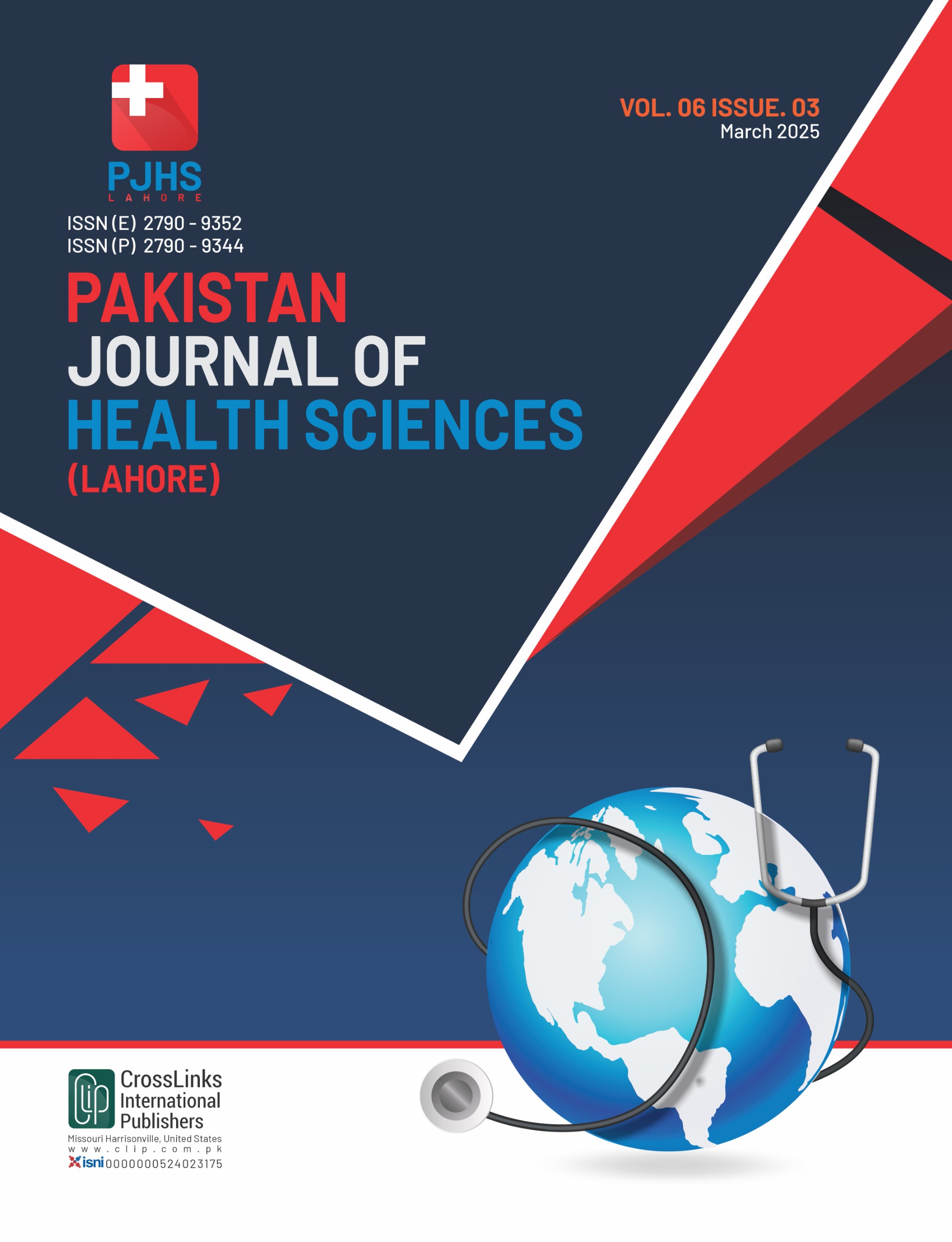Femoral Condyle Measurements in Anterior Cruciate Ligament Injury: 1 Tesla Magnetic Resonance Imaging Analysis
Femoral Condyle Measurements in Ligament Injury
DOI:
https://doi.org/10.54393/pjhs.v6i3.2774Keywords:
Femoral Condyle Dimensions, Anterior Cruciate Ligament Injury, Magnetic Resonance Imaging, Knee Biomechanics AnalysisAbstract
Orthopedic injury of Anterior Cruciate Ligament (ACL) remains an increasingly frequent issue that primarily affects athletes with permanent complications as a result. The modern Magnetic Resonance Imaging (MRI) technology enables better accuracy when measuring femoral condyles. Objective: To investigate the dimension analysis of the femoral condyles regarding ACL injuries alongside their implications for both surgical procedures and preventive management. Methods: Descriptive cross-sectional study from September 2023 to August 2024 in the Orthopedic department. The study enrolled 385 participants between 18 to 60 years old. All subjects completed scanning with a 1 Tesla MRI and the researchers recorded femoral condyle dimensions. Data analysis occurred with SPSS version 26.0. while linear regression and ANOVA. Results: The research analysis involved 385 participants whose mean age equaled 34.7 ± 6.95 years. The majority were male (70.6%). Mean measurement of Lateral Condyle AP was 6.28 ± 0.43 cm while Medial Condyle AP recorded 6.11 ± 0.46 cm, and Trans-epicondylar Axis reached 7.96 ± 0.53 cm. ANOVA analysis found significant measurement distinctions in knee joints that occurred between different age groups (p<0.001). The results from independent t-tests showed knee measurement discrepancies between men and women signify statistical significance at p<0.001. Conclusions: This research demonstrated that the dimensions of femoral condyles act as major factors that determine risk for ACL injuries. Preventive strategies alongside treatment plans for ACL injuries need to adopt age- and sex-specific considerations according to the research results.
References
Parsons JL, Coen SE, Bekker S. Anterior cruciate ligament injury: towards a gendered environmental approach. British Journal of Sports Medicine. 2021 Sep; 55(17): 984-90. doi: 10.1136/bjsports-2020-103173. DOI: https://doi.org/10.1136/bjsports-2020-103173
Rothrauff BB, Jorge A, de Sa D, Kay J, Fu FH, Musahl V. Anatomic ACL reconstruction reduces risk of post-traumatic osteoarthritis: a systematic review with minimum 10-year follow-up. Knee Surgery, Sports Traumatology, Arthroscopy. 2020 Apr; 28: 1072-84. doi: 10.1007/s00167-019-05665-2. DOI: https://doi.org/10.1007/s00167-019-05665-2
Li R, Liu Y, Fang Z, Zhang J. Introducing the lateral femoral condyle index as a risk factor for anterior cruciate ligament injury. The American Journal of Sports Medicine. 2020 Jun; 48(7): NP42-. doi: 10.1177/0363546520920546. DOI: https://doi.org/10.1177/0363546520920546
Li Z, Li C, Li L, Wang P. Correlation between notch width index assessed via magnetic resonance imaging and risk of anterior cruciate ligament injury: an updated meta-analysis. Surgical and Radiologic Anatomy. 2020 Oct; 42: 1209-17. doi: 10.1007/s00276-020-02496-6. DOI: https://doi.org/10.1007/s00276-020-02496-6
Pfeiffer TR, Burnham JM, Hughes JD, Kanakamedala AC, Herbst E, Popchak A et al. An increased lateral femoral condyle ratio is a risk factor for anterior cruciate ligament injury. Journal of Bone and Joint Surgery. 2018 May; 100(10): 857-64. doi: 10.2106/JBJS.17.01011. DOI: https://doi.org/10.2106/JBJS.17.01011
Shi WL, Gao YT, Zhang KY, Liu P, Yang YP, Ma Y et al. Femoral tunnel malposition, increased lateral tibial slope, and decreased notch width index are risk factors for non-traumatic anterior cruciate ligament reconstruction failure. Arthroscopy: The Journal of Arthroscopic and Related Surgery. 2024 Feb; 40(2): 424-34. doi: 10.1016/j.arthro.2023.06.049. DOI: https://doi.org/10.1016/j.arthro.2023.06.049
Abdurahmаnovich НO. Diagnostics of injuries of the soft tissue structures of the knee joint and their complications. European research. 2020; (1 (37)): 33-5.
Zhang C, Xie G, Fang Z, Zhang X, Huangfu X, Zhao J. Assessment of relationship between three dimensional femoral notch volume and anterior cruciate ligament injury in Chinese Han adults: a retrospective MRI study. International Orthopaedics. 2019 May; 43: 1231-7. doi: 10.1007/s00264-018-4068-7. DOI: https://doi.org/10.1007/s00264-018-4068-7
Siouras A, Moustakidis S, Giannakidis A, Chalatsis G, Liampas I, Vlychou M et al. Knee injury detection using deep learning on MRI studies: a systematic review. Diagnostics. 2022 Feb; 12(2): 537. doi: 10.3390/diagnostics12020537. DOI: https://doi.org/10.3390/diagnostics12020537
Meier MP, Hochrein Y, Saul D, Seitz MT, Roch PJ, Jäckle K et al. Physiological Femoral Condylar Morphology in Adult Knees-A MRI Study of 517 Patients. Diagnostics. 2023 Jan; 13(3): 350. doi: 10.3390/diagnostics13030350. DOI: https://doi.org/10.3390/diagnostics13030350
Chaurasia A, Tyagi A, Santoshi JA, Chaware P, Rathinam BA, Rathinam BA. Morphologic features of the distal femur and proximal tibia: a cross-sectional study. Cureus. 2021 Jan; 13(1). doi: 10.7759/cureus.12907. DOI: https://doi.org/10.7759/cureus.12907
Hart A, Sivakumaran T, Burman M, Powell T, Martineau PA. A prospective evaluation of femoral tunnel placement for anatomic anterior cruciate ligament reconstruction using 3-dimensional magnetic resonance imaging. The American Journal of Sports Medicine. 2018 Jan; 46(1): 192-9. doi: 10.1177/0363546517730577. DOI: https://doi.org/10.1177/0363546517730577
Attia MH, Kholief MA, Zaghloul NM, Kružić I, Anđelinović Š, Bašić Ž et al. Efficiency of the adjusted binary classification (ABC) approach in osteometric sex estimation: A comparative study of different linear machine learning algorithms and training sample sizes. Biology. 2022 Jun; 11(6): 917. doi: 10.3390/biology11060917. DOI: https://doi.org/10.3390/biology11060917
Refaat M, El Shazly E, Elsayed A. Role of MR imaging in evaluation of traumatic knee lesions. Benha Medical Journal. 2020 Oct; 37(special issue (Radiology)): 77-86. doi: 10.21608/bmfj.2020.110137. DOI: https://doi.org/10.21608/bmfj.2020.110137
Chia L, De Oliveira Silva D, Whalan M, McKay MJ, Sullivan J, Fuller CW et al. Non-contact anterior cruciate ligament injury epidemiology in team-ball sports: a systematic review with meta-analysis by sex, age, sport, participation level, and exposure type. Sports Medicine. 2022 Oct; 52(10): 2447-67. doi: 10.1007/s40279-022-01697-w. DOI: https://doi.org/10.1007/s40279-022-01697-w
World Population review. Peshawar, Pakistan Population. [Cited: 27th Aug 2024]. Available at: https://worldpopulationreview.com/cities/pakistan/peshawar.
Cheng FB, Ji XF, Lai Y, Feng JC, Zheng WX, Sun YF et al. Three dimensional morphometry of the knee to design the total knee arthroplasty for Chinese population. The Knee. 2009 Oct; 16(5): 341-7. doi: 10.1016/j.knee.2008.12.019. DOI: https://doi.org/10.1016/j.knee.2008.12.019
Thompson WW. Vital signs: hepatitis C treatment among insured adults-United States, 2019-2020. Morbidity and Mortality Weekly Report. 2022 Aug; 71. doi: 10.15585/mmwr.mm7132e1. DOI: https://doi.org/10.15585/mmwr.mm7132e1
Şenişik S, Özgürbüz C, Ergün M, Yüksel O, Taskiran E, İşlegen Ç et al. Posterior tibial slope as a risk factor for anterior cruciate ligament rupture in soccer players. Journal of Sports Science and Medicine. 2011 Dec; 10(4): 763-767.
Dalury DF, Ewald FC, Christie MJ, Scott RD. Total knee arthroplasty in a group of patients less than 45 years of age. The Journal of Arthroplasty. 1995 Oct; 10(5): 598-602. doi: 10.1016/S0883-5403(05)80202-5. DOI: https://doi.org/10.1016/S0883-5403(05)80202-5
Souryal TO and Freeman TR. Intercondylar notch size and anterior cruciate ligament injuries in athletes: a prospective study. The American Journal of Sports Medicine. 1993 Jul; 21(4): 535-9. doi: 10.1177/036354659302100410. DOI: https://doi.org/10.1177/036354659302100410
Wang HM, Shultz SJ, Ross SE, Henson RA, Perrin DH, Schmitz RJ. ACL size and notch width between ACLR and healthy individuals: a pilot study. Sports Health. 2020 Jan; 12(1): 61-5. doi: 10.1177/1941738119873631. DOI: https://doi.org/10.1177/1941738119873631
Park JS, Nam DC, Kim DH, Kim HK, Hwang SC. Measurement of knee morphometrics using MRI: a comparative study between ACL-injured and non-injured knees. Knee Surgery and Related Research. 2012 Sep; 24(3): 180. doi: 10.5792/ksrr.2012.24.3.180. DOI: https://doi.org/10.5792/ksrr.2012.24.3.180
Gultekin MZ, Dinçel YM, Keskin Z, Arslan S, Yıldırım A. Morphometric risk factors effects on anterior cruciate ligament injury. Joint Diseases and Related Surgery. 2022 Dec; 34(1): 130. doi: 10.52312/jdrs.2023.910. DOI: https://doi.org/10.52312/jdrs.2023.910
Liu HC. Review of gross anatomy of the Chinese knee. Taiwan yi xue hui za zhi. Journal of the Formosan Medical Association. 1984 Mar; 83(3): 317-25.
Irarrázaval S. Variations in anterior cruciate ligament anatomy. Operative Techniques in Orthopaedics. 2017 Mar; 27(1): 8-13. doi: 10.1053/j.oto.2017.01.003. DOI: https://doi.org/10.1053/j.oto.2017.01.003
Mensch JS and Amstutz HC. Knee morphology as a guide to knee replacement. Clinical Orthopaedics and Related Research. 1975 Oct; 1(112): 231-41. doi: 10.1097/00003086-197510000-00029. DOI: https://doi.org/10.1097/00003086-197510000-00029
Downloads
Published
How to Cite
Issue
Section
License
Copyright (c) 2025 Pakistan Journal of Health Sciences

This work is licensed under a Creative Commons Attribution 4.0 International License.
This is an open-access journal and all the published articles / items are distributed under the terms of the Creative Commons Attribution License, which permits unrestricted use, distribution, and reproduction in any medium, provided the original author and source are credited. For comments













